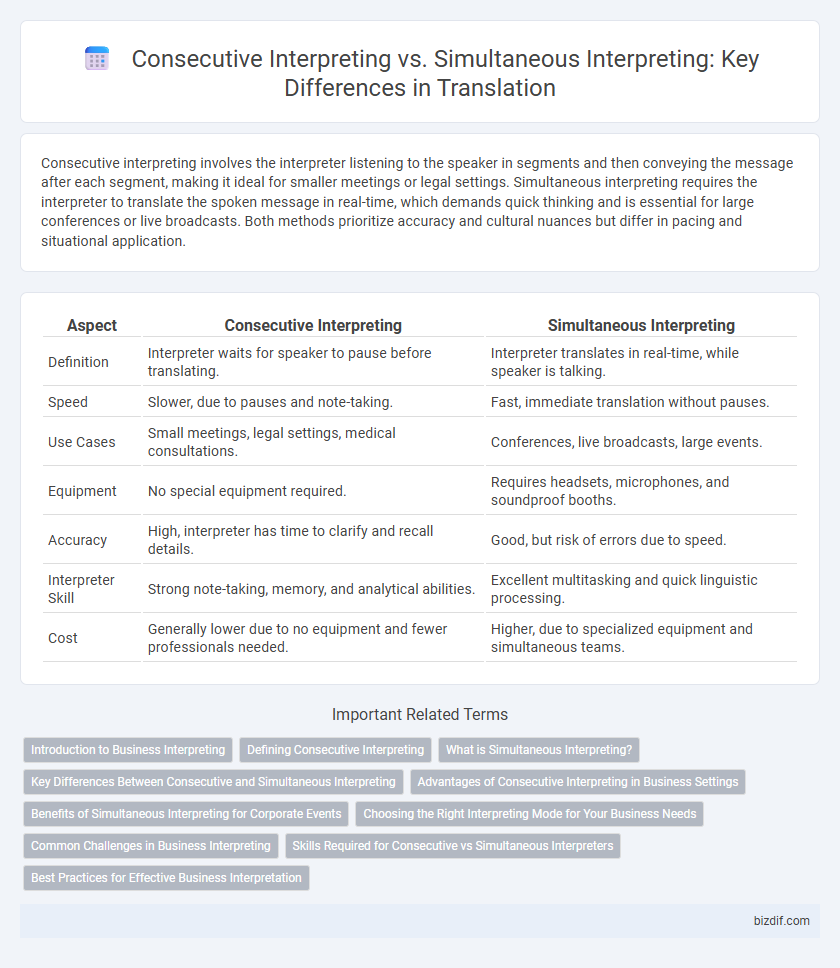Consecutive interpreting involves the interpreter listening to the speaker in segments and then conveying the message after each segment, making it ideal for smaller meetings or legal settings. Simultaneous interpreting requires the interpreter to translate the spoken message in real-time, which demands quick thinking and is essential for large conferences or live broadcasts. Both methods prioritize accuracy and cultural nuances but differ in pacing and situational application.
Table of Comparison
| Aspect | Consecutive Interpreting | Simultaneous Interpreting |
|---|---|---|
| Definition | Interpreter waits for speaker to pause before translating. | Interpreter translates in real-time, while speaker is talking. |
| Speed | Slower, due to pauses and note-taking. | Fast, immediate translation without pauses. |
| Use Cases | Small meetings, legal settings, medical consultations. | Conferences, live broadcasts, large events. |
| Equipment | No special equipment required. | Requires headsets, microphones, and soundproof booths. |
| Accuracy | High, interpreter has time to clarify and recall details. | Good, but risk of errors due to speed. |
| Interpreter Skill | Strong note-taking, memory, and analytical abilities. | Excellent multitasking and quick linguistic processing. |
| Cost | Generally lower due to no equipment and fewer professionals needed. | Higher, due to specialized equipment and simultaneous teams. |
Introduction to Business Interpreting
Consecutive interpreting involves the interpreter listening to the speaker, taking notes, and then delivering the translation during natural pauses, making it ideal for business meetings and negotiations where accuracy and detail are paramount. Simultaneous interpreting requires real-time translation with minimal delay, commonly used in international conferences and large multilingual corporate events to ensure smooth communication across diverse audiences. Business interpreting demands both methods depending on context, with consecutive suited for smaller, detail-oriented interactions and simultaneous preferred for fast-paced, large-scale engagements.
Defining Consecutive Interpreting
Consecutive interpreting involves the interpreter listening to a speaker's message before rendering it into the target language during pauses, allowing for accurate and context-rich translations. This method is commonly used in legal, medical, and business settings where precision and clarity are critical. Unlike simultaneous interpreting, consecutive interpreting requires strong note-taking skills and memory retention to ensure the full meaning is conveyed.
What is Simultaneous Interpreting?
Simultaneous interpreting involves real-time translation of spoken language as the speaker continues talking, enabling immediate communication across different languages. Interpreters use specialized equipment such as headsets and soundproof booths to deliver precise and timely interpretations without interrupting the speaker. This method is essential in international conferences, live broadcasts, and multilingual meetings where continuous, instant understanding is critical.
Key Differences Between Consecutive and Simultaneous Interpreting
Consecutive interpreting involves the interpreter listening to a speaker and then delivering the translation during natural pauses, allowing for detailed and accurate renditions of complex or technical content. Simultaneous interpreting requires the interpreter to translate the message in real-time, typically using specialized equipment, which is essential for conferences and live broadcasts where timing is critical. Key differences include the timing of delivery, the cognitive demand on interpreters, and the suitability of each method for different settings such as business meetings or international summits.
Advantages of Consecutive Interpreting in Business Settings
Consecutive interpreting allows for more accurate and nuanced communication in business settings by enabling interpreters to capture the speaker's message in segments, reducing the risk of errors common in simultaneous interpreting. This method fosters better engagement and trust during negotiations, as participants can actively listen and respond without being overwhelmed by continuous interpretation. Additionally, consecutive interpreting requires less technical equipment, making it a cost-effective solution for smaller meetings and informal business discussions.
Benefits of Simultaneous Interpreting for Corporate Events
Simultaneous interpreting enhances corporate events by allowing real-time communication across multiple languages, eliminating delays and maintaining audience engagement. It supports complex business discussions and negotiations by providing immediate understanding, which boosts decision-making efficiency. High accuracy and the ability to handle large-scale international meetings make simultaneous interpreting essential for global corporations seeking seamless multilingual interaction.
Choosing the Right Interpreting Mode for Your Business Needs
Choosing the right interpreting mode depends on your business's communication goals and event format. Consecutive interpreting suits smaller meetings and detailed exchanges, ensuring precise message delivery without requiring specialized equipment. Simultaneous interpreting is ideal for large conferences or multilingual events, offering real-time translation to maintain flow and audience engagement.
Common Challenges in Business Interpreting
Consecutive interpreting in business contexts often faces challenges such as memory retention and note-taking accuracy, which can impact the interpreter's ability to deliver precise and timely translations. Simultaneous interpreting demands high cognitive stamina and the capacity to process and translate information in real-time, increasing the risk of errors under pressure. Both modalities require cultural competence and subject-specific knowledge to effectively convey nuanced business terminology and maintain communication clarity across languages.
Skills Required for Consecutive vs Simultaneous Interpreters
Consecutive interpreting demands exceptional note-taking abilities, strong memory retention, and precise analytical skills to accurately convey messages after the speaker pauses. Simultaneous interpreting requires rapid cognitive processing, advanced multitasking capabilities, and fluency in both source and target languages to interpret in real-time without interrupting the speaker. Both modes necessitate cultural competence and subject matter expertise, but the cognitive load and response time vary significantly between them.
Best Practices for Effective Business Interpretation
Consecutive interpreting requires the interpreter to listen carefully, take precise notes, and deliver accurate translations during speaker pauses, emphasizing active memory retention and clear communication. Simultaneous interpreting demands advanced concentration, the use of high-quality audio equipment, and minimizing latency to ensure real-time translation without disrupting the speaker's flow. Effective business interpretation combines rigorous preparation, familiarity with industry-specific terminology, and cultural awareness to maintain message integrity across both consecutive and simultaneous methods.
Consecutive Interpreting vs Simultaneous Interpreting Infographic

 bizdif.com
bizdif.com